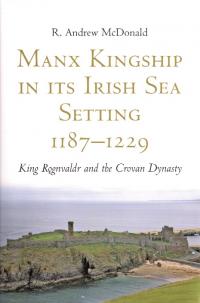Manx kingship in its Irish Sea setting 1187–1229: King Rognvaldr and the Crovan dynasty
Published in Issue 2(March/April 2012), Medieval History (pre-1500), Reviews, Volume 20
Manx kingship in its Irish Sea setting 1187–1229:
King Rognvaldr and the Crovan dynasty
R. Andrew McDonald
(Four Courts Press, €55)
ISBN 9781846820472
At first glance, the publication of a book on a medieval Manx dynasty might seem to have little to offer Irish historians. Today, the Isle of Man barely registers in the Irish consciousness, having become largely peripheral to the cultural and political milieu of modern Europe. This, however, was not always the case. In a time when the seaways were highways, medieval Man sat astride strategic maritime crossroads at the intersection of the Anglo-Norman, Celtic and Scandinavian worlds. This made the small island a melting-pot of languages, cultures and political world-views, and its kings key players in the politics of the Irish Sea region, where their fleets could offer security or peril. Man’s early history is linked to Ireland’s. Its indigenous culture was superseded by a Celtic migration in the prehistoric era. Then, from around AD 450, there followed an Early Christian period, interrupted in the late eighth or early ninth century by the first Viking activity on the island. The Norse ‘kingdom of Man’ was established in the late eleventh century by Gu?rø?r Crovan (d. 1095)—also known as Gofraid Méránach (‘the furious’)—who was likely a member of the ruling Ostman dynasty of Dublin (p. 62). His descendants then ruled it for almost two centuries until it was surrendered to Scotland in 1266.Despite the importance of the medieval kingdom of Man, little has been published on it. R. Andrew McDonald seeks to remedy this by taking the reign of Gu?rø?r’s great-grandson, R?gnvaldr Gu?rø?arson (1187–1229), as the focal point for an analysis of the entire Crovan dynasty. The choice of R?gnvaldr is an obvious one, because his reign is the best documented by far. The native Manx Chronicle pays especially close attention to R?gnvaldr, and he also has the distinction of not only featuring in a Norse saga but also being the subject of an Irish praise-poem. Furthermore, from c. 1200, English chancery enrolments provide detailed information regarding R?gnvaldr’s interactions with England. Irish, English, Scottish and Welsh annals and chronicles add to the diversity of sources that McDonald marshals to bring King R?gnvaldr to life. The book opens with a detailed introduction, which conveys the author’s passion for his subject. An outline of the book is followed by a brief overview of relevant secondary literature and a discussion of the sources available for the period. Chapter 1 deals with the physical and political settings of R?gnvaldr’s kingship. McDonald familiarises the reader with the geography and topography of the Isle of Man, before providing a narrative of the history of the Crovan dynasty from its progenitor, Gu?rø?r Crovan, to R?gnvaldr’s father, Gu?rø?r Óláfsson (d. 1187).Chapter 2 continues this chronology, detailing the succession dispute between R?gnvaldr and his brother Óláfr that persisted throughout R?gnvaldr’s reign. McDonald then broadens the perspective to explore kin-strife and factionalism within the Crovan dynasty in general, both before and after R?gnvaldr. Chapters 3 and 4 focus on R?gnvaldr’s foreign relations. Besides being the brother-in-law of John de Courcy, the celebrated conqueror of Uladh, and cultivating alliances with the rulers of Galloway and Gwynedd, R?gnvaldr also paid homage to the kings of England and Norway before surrendering his kingdom to the pope (to be held as a papal fief) in 1219. Weaving together strands from various sources, McDonald produces a fascinating analysis of R?gnvaldr’s career while highlighting the interconnectedness of medieval northern Europe. The final chapter, on the nature of Manx kingship, is by far the longest of the five. First analysing the legitimacy of the Manx royal title, McDonald then explores how the kings might have been chosen and inaugurated through an examination of contemporary Irish and Scottish practices and later Manx statutes. He comments on the Christian dimension of Manx kingship, before ending his work with sections on the role and authority of the king of Man. This is an ambitious book, and, as such, will attract its share of criticism. While the benefits of McDonald’s inclusive approach to history far outweigh the risks involved, by incorporating aspects of Irish, Scottish, English, Welsh, Norwegian and papal history McDonald has left himself open to criticism from many quarters. One point that may be of particular concern to non-Manx historians is the orthography of names, which is more about the current state of research than McDonald’s book in particular. The use of Old Norse name forms (e.g. R?gnvaldr, Gu?rø?r), as opposed to the more modern variations that have gained historiographical currency (e.g. Ragnvald, Godred), risks pigeonholing as definitively Norse men whose cosmopolitan characters McDonald talks up so successfully. The process is also fraught with difficult decisions. For instance, in this book we have two cousins of the same name contemporaneously claiming to be ‘king of the Isles’. Under the new convention one is styled R?gnvaldr, the other Ragnall (the Gaelic form), even though each was known by both names (and others) by contemporaries. McDonald addresses the issue of orthography from the outset, but it may take some time for non-Manx historians to adjust to the new standard and recognise old characters in their new forms. All in all, this is an excellent book, fit for the casual reader and specialist alike. McDonald writes in a style that is both accessible and informative, providing ample background information without insulting the reader’s intelligence. HI
Colin Veach is a member of staff at the Medieval History Research Centre, Trinity College, Dublin.
















